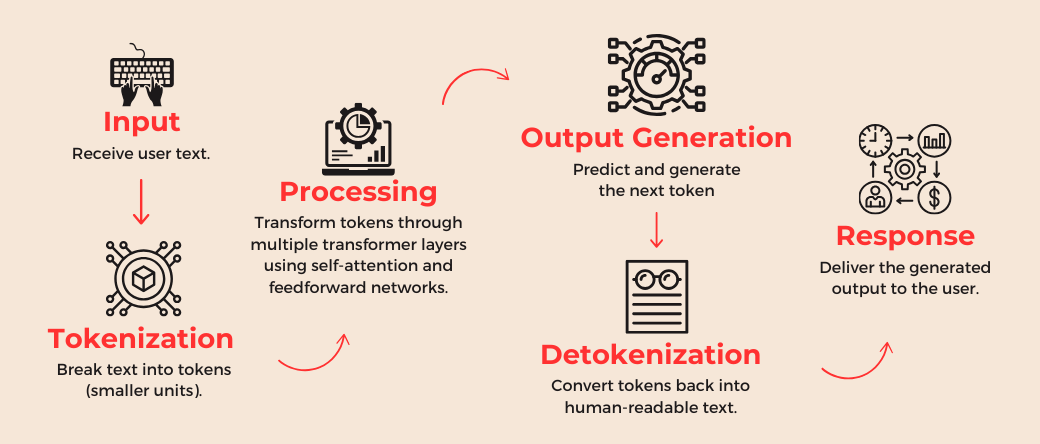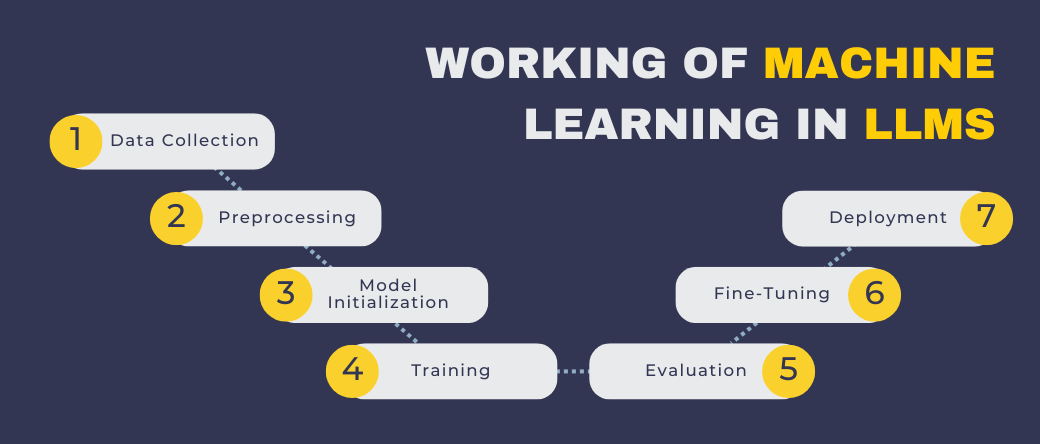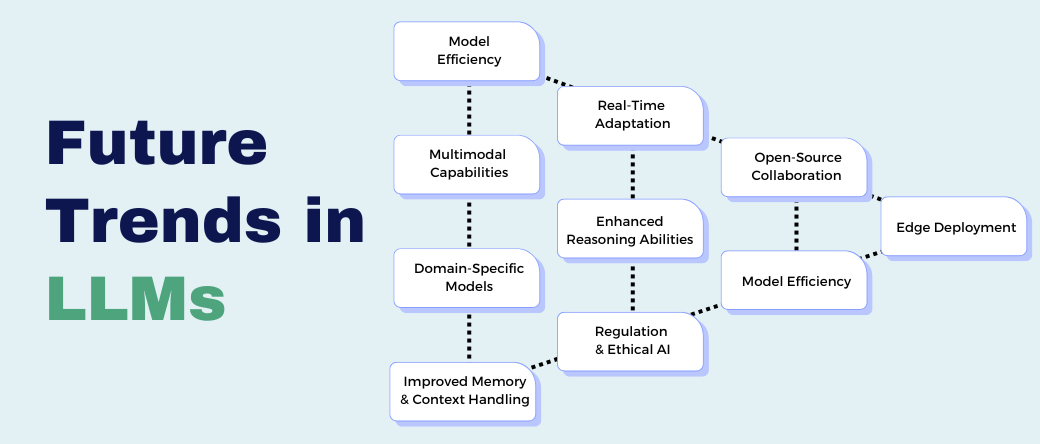Large Language Models (LLMs) are powerful AI systems that help computers understand and produce language similarly to humans, leading to significant advancements in artificial intelligence. AI has revolutionized various industries by automating tasks, improving decision-making, and enhancing user experiences. For example, in healthcare, LLMs assist in analyzing patient records to provide faster diagnoses. In finance, they detect fraudulent activities by identifying anomalies in transaction data, saving institutions billions of dollars annually.
Moreover, education has been transformed with personalized learning platforms powered by LLMs, tailoring content to individual needs. Even in entertainment, LLMs are used to generate scripts or power AI-driven storytelling platforms. LLMs are not just tools; they represent a shift in how humans and technology interact, creating opportunities for innovation and efficiency across all domains.
This guide dives into the fundamentals of LLMs, their working mechanisms, their transformative potential across industries, and how to use them effectively while considering ethical implications.
What is an LLM?
A Large Language Model (LLM) is an AI system designed to process, understand, and generate human language. These models use deep learning techniques to analyze vast amounts of textual data, enabling them to perform tasks ranging from language translation to complex problem-solving.
Key Characteristics of LLMs
- Large Datasets: LLMs are trained on billions of words collected from diverse sources, including books, academic papers, and online content. This diverse dataset allows them to understand a wide range of topics and contexts.
- Predictive Power: LLMs generate text by predicting the next word in a sequence based on context. This enables them to produce coherent and meaningful sentences.
- Adaptability: LLMs can be fine-tuned for specific applications, such as summarizing legal documents, automating customer support, or assisting in creative writing.
The Process of How an LLM Works
- Data Collection and Preprocessing
- Large amounts of text data (books, websites, articles) are gathered.
- The text is tokenized into smaller units (words or subwords).
- Model Training
- The model is trained using a neural network, particularly a transformer architecture.
- It identifies patterns and relationships in the data, such as grammar, syntax, and context.
- Through multiple iterations, the model improves its ability to predict the next token in a sequence.
- Attention Mechanism
- The attention mechanism allows the model to focus on relevant parts of the text.
- It ensures that the model understands the context of each token, even in long text sequences.
- Prediction
- When given an input, the model calculates the probability of possible next tokens.
- It selects the most likely sequence based on the context provided.
- Fine-Tuning (Optional)
- The pre-trained model can be fine-tuned for specific tasks, such as customer support, summarization, or technical writing.

Real-World Example: Is ChatGPT an LLM?
Yes, ChatGPT is a quintessential LLM. For instance, when you ask ChatGPT, “What is the capital of France?” it retrieves contextual knowledge and provides the correct answer: “Paris.” This interaction demonstrates how LLMs use contextual understanding to deliver accurate responses.
Moreover, ChatGPT can engage in extended conversations, remember the context within a session, and adapt its tone based on user input, showcasing the adaptability of modern LLMs.
How Does Machine Learning Work in LLMs?
LLMs rely on a branch of artificial intelligence called deep learning. They use neural networks to process and learn from data, enabling them to understand and generate human-like text. Here’s an in-depth look at their learning process:
Step 1: Data Collection
Massive datasets are collected from various sources, including:
- Books and Academic Journals: For formal and structured language.
- Web Content: For conversational and informal text.
- Specialized Databases: For niche knowledge, such as medical or legal texts.
For example, GPT-4 was trained on diverse datasets, enabling it to answer technical questions and create creative content with equal ease.
Step 2: Training with Neural Networks
The collected data is processed using deep neural networks. These networks consist of layers of nodes (neurons) that:
- Identify Patterns: Analyze relationships between words.
- Learn Context: Understand the meaning of words based on their surrounding text.
- Generate Predictions: Determine the most likely next word or phrase in a sentence.
Step 3: Context Recognition
LLMs use tokenization to break down text into smaller units (tokens). For instance:
- Input: “The quick brown fox jumps over the lazy dog.”
- Tokens: [“The”, “quick”, “brown”, “fox”, “jumps”, “over”, “the”, “lazy”, “dog”].
The model processes these tokens to understand relationships and generate contextually appropriate responses.
Step 4: Text Generation
When prompted, the model predicts the sequence of words that best match the context. For instance:
- Prompt: “Once upon a time in a faraway land,”
- Response: “there lived a wise old king who ruled with kindness and fairness.”

How to Use Multiple Machines for LLMs
The complexity of training LLMs demands significant computational resources, often requiring multiple machines working together. This distributed approach ensures faster and more efficient processing of large datasets.
How It Works
- Data Parallelism: Training data is split into smaller chunks, with each machine processing a portion simultaneously. This approach minimizes memory bottlenecks and speeds up computation by allowing each machine to handle a manageable workload.
Challenges: Managing synchronization across machines is crucial to avoid inconsistencies in data updates. Additionally, ensuring that data splits are balanced in complexity can be difficult. - Model Parallelism: The model is divided into segments, and different machines handle specific layers or components. This is especially useful for handling extremely large models that cannot fit into the memory of a single machine.
Challenges: Communication between machines becomes critical, as the output of one machine may serve as the input for another. Latency and network efficiency can significantly impact overall performance. The model is divided into segments, and different machines handle specific layers or components.
Real-World Example
Platforms like Databricks provide tools for distributed training. For example, when training a medical LLM to analyze patient data, splitting the workload across GPUs reduces training time and improves model accuracy.
New Techniques in LLM for Text Processing
Modern LLMs employ advanced techniques to enhance their efficiency and accuracy. Here’s an overview:
1. Transformers
Transformers revolutionized AI by introducing the attention mechanism, which allows models to focus on the most relevant parts of input text.
- Example: In the sentence “She read the book on the table,” the model identifies that “on the table” modifies “the book.”
2. Few-Shot and Zero-Shot Learning
- Few-Shot Learning: The model learns a task with limited examples. For instance, generating a product description after seeing only a few samples.
- Zero-Shot Learning: The model performs tasks without prior examples, leveraging its generalized knowledge.
3. Fine-Tuning
Customizing pre-trained models for specialized tasks. For instance, fine-tuning an LLM for:
- Legal Analysis: Summarizing court rulings.
- Creative Writing: Generating poetry or fiction.
4. Reinforcement Learning with Human Feedback (RLHF)
This technique involves human evaluators providing feedback to refine the model’s responses. It ensures outputs align with ethical standards and user expectations.
LLM Applications Across Industries
1. Healthcare
- Clinical Documentation: Automating the creation of patient summaries.
- Diagnostics: Assisting doctors by analyzing symptoms and medical records.
- Telemedicine: Powering conversational AI tools for remote consultations.
2. Finance
- Fraud Detection: Identifying unusual transaction patterns.
- Customer Support: Automating responses to common banking queries.
- Market Analysis: Summarizing financial reports and trends.
3. Retail and E-Commerce
- Personalized Recommendations: Suggesting products based on user behavior.
- Chatbots: Providing real-time customer support.
- Review Analysis: Analyzing sentiment in customer feedback to improve products.
4. Education
- Tutoring: Offering personalized learning experiences.
- Content Creation: Generating lesson plans or quizzes.
- Research Assistance: Summarizing academic papers.
Future Trends in LLMs
1. Multimodal LLMs
Multimodal LLMs represent the next evolution of language models by integrating various types of data such as text, images, and audio. This enables the creation of models that can process and generate more complex outputs.
For instance, a multimodal LLM could be used in content creation by generating video scripts and their corresponding visuals. In healthcare, such models could analyze medical images like X-rays alongside patient notes for a holistic diagnosis.
Speculative Applications:
- Augmented Reality (AR) Tools: Multimodal LLMs could power AR devices to generate on-the-fly contextual overlays, such as translating street signs while traveling.
- Smart Educational Tools: Combining video, audio, and text to create immersive virtual tutors that adapt to individual learning needs.
Challenges:
- Data Integration: Combining data from diverse formats without losing accuracy.
- Resource Intensity: These models require even greater computational power than text-only LLMs.
- Ethical Considerations: Ensuring that multimodal outputs do not propagate biases inherent in diverse data types. Combining text, images, and audio to create more versatile models. For example, a multimodal LLM could generate video scripts from textual descriptions.
2. Open-Source Models
Projects like BLOOM and Hugging Face aim to democratize AI, making LLMs accessible to a broader audience.
3. Ethical AI
Ensuring fairness, transparency, and accountability in AI development will remain a critical focus. Techniques like bias mitigation and explainability will gain prominence.
4. Integration with IoT
Smart devices powered by LLMs will enhance user experiences, from home automation to industrial applications.

Conclusion
Large Language Models are reshaping how we interact with technology, providing solutions that range from automating tasks to creating content. As LLMs continue to evolve, they promise to unlock new opportunities across industries, improve efficiency, and foster innovation. Understanding their mechanisms and applications is the first step in leveraging their potential to drive meaningful change.
FAQs
1. What is an LLM?
An LLM, or Large Language Model, is an advanced AI system that processes and generates human-like language. It is trained on massive datasets, including books, articles, and online content, enabling it to understand context, recognize patterns, and provide meaningful responses. LLMs are widely used for natural language understanding tasks, such as conversational AI, text summarization, and language translation.
2. How do LLMs work?
LLMs function by breaking down text into smaller parts, known as tokens, and analyzing the relationships between these tokens. They leverage transformer architectures, which include attention mechanisms, to focus on the most relevant parts of a text. This allows them to understand the context and generate coherent and accurate outputs. For instance, an LLM can answer a question, compose an email, or even write creative stories based on the input it receives.
3. What are some real-world applications of LLMs?
LLMs have diverse applications across industries, including
- Healthcare: Automating medical transcription and aiding in diagnostics by analyzing symptoms and patient history.
- Finance: Detecting fraud by identifying anomalies in transactions and automating report generation.
- Education: Summarizing lengthy research papers, creating quizzes, and providing personalized tutoring.
- E-commerce: Powering chatbots to handle customer queries and offering tailored product recommendations based on user behavior. LLMs continue to revolutionize industries by automating tasks and improving efficiency.
4. Are there any ethical concerns with using LLMs?
Yes, the use of LLMs raises several ethical concerns, such as
- Bias in Data: If training datasets contain biases, the model may generate discriminatory or unfair outputs.
- Privacy Issues: Without proper safeguards, sensitive data may be exposed during training or use.
- Misinformation: LLMs can sometimes generate incorrect or misleading information, particularly in areas where their training data is limited.\n Mitigating these concerns requires careful auditing, transparency, and continuous improvement of these models.
5. What are some free LLMs available?
Several free or open-source LLMs provide powerful capabilities without hefty costs
- BLOOM: A multilingual, open-source LLM trained on diverse datasets.
- OpenAI GPT-3 Playground: Offers limited free usage for experimentation and learning.
- Hugging Face Models: A platform with numerous pre-trained models ready for deployment in various applications. These models lower the barrier to entry, making it easier for developers and businesses to integrate LLM capabilities.






